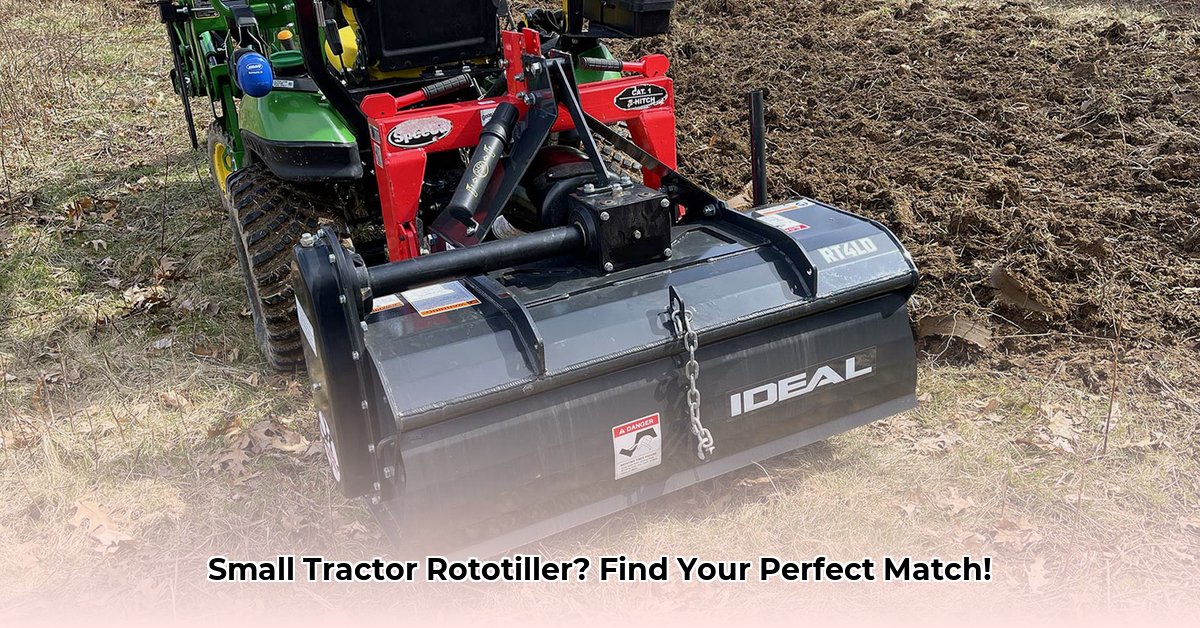
Choosing the right rototiller is crucial for sustainable small-scale farming. It directly impacts soil health, crop yields, and the overall efficiency of your operation. This guide helps you navigate the diverse market and select a rototiller optimized for your specific needs and budget. For more information on tractor rototillers, check out this helpful resource: Tractor Rototillers.
1. Assessing Your Needs: A Personalized Approach
Before exploring models, understand your farming context. This personalized assessment ensures you select a tool perfectly matched to your operation.
1.1 Farm Size: How many acres need tilling? This dictates the necessary tiller width. Wider models cover more ground per pass, saving time and labor, but may be overkill for smaller plots.
1.2 Soil Type: Is your soil heavy clay, sandy loam, or something else? Soil type greatly influences tiller selection. Heavy clay requires aggressive tilling, while lighter soils benefit from gentler approaches. Ignoring this can lead to soil compaction or unnecessary damage.
1.3 Budget: Rototillers range widely in price. Establish a realistic budget, considering not only the initial cost but also ongoing maintenance and the machine's projected lifespan. A more expensive, durable model often proves more cost-effective in the long run.
1.4 Usage Frequency: How often will you till? Infrequent use justifies a less expensive model, while frequent use necessitates a robust, heavy-duty tiller built for longevity. This impacts both the initial investment and long-term cost.
Considering these factors creates a clear picture of your ideal rototiller.
2. Decoding Rotary Tiller Features: The Technical Aspects
Understanding the technical nuances of rototillers ensures you choose a model aligned with your specific needs and farming practices.
2.1 Tine Design: Tines are the working components of the rototiller.
L-shaped tines: Offer aggressive tilling, excellent for breaking up compacted soil but potentially damaging lighter soils. They are powerful and effective in difficult conditions.
C-shaped tines: Provide gentler tilling, ideal for lighter soils, and creating a finer tilth. They are less likely to cause excessive soil disturbance.
The optimal tine type depends entirely on your soil characteristics.
2.2 Gearbox Type: The gearbox transmits power from the tractor to the tiller.
Gear-driven: Renowned for durability and efficient power transfer. They demand more maintenance, yet provide reliable performance. "Gear-driven tillers are the workhorses of the industry," says Dr. Emily Carter, Agricultural Engineer, University of California, Davis.
Chain-driven: Require less maintenance but might wear out faster than gear-driven systems and may be less efficient in transmitting power.
The ideal gearbox choice balances your maintenance capacity with your need for reliable performance.
2.3 Adjustability: The ability to adjust both tilling depth and width is crucial for adapting to various soil conditions and crop needs. This flexibility maximizes efficiency and reduces waste from over-tilling.
2.4 Build Quality: Durable construction is essential for longevity. Heavy-duty steel and cast iron components signify a longer lifespan compared to lighter materials that may be better suited for occasional use. Pay attention to the build quality and material used, as these significantly impact the tiller's lifetime.
3. Top Models: A Comparative Overview
Direct comparison of rototiller models is challenging due to limited standardized testing. However, analyzing leading models highlights key differences. Remember that availability varies regionally.
| Model | Tine Type | Drive Type | Adjustability | Durability | Estimated Price (USD) | Pros | Cons |
|---|---|---|---|---|---|---|---|
| King Kutter RK70 | L-shaped | Gear | Good | High | $1200 - $1800 | Maneuverable, lightweight, suitable for smaller farms | May struggle with extremely tough or rocky soil |
| Bush Hog 200 Series | C-shaped | Gear | Excellent | Very High | $2000 - $3000 | Robust, powerful, ideal for larger areas | Heavier, more expensive, less maneuverable |
(Note: Prices are approximate and can vary based on retailer and specific features. Consult your local dealer for exact pricing.)
This table provides a general comparison. User reviews and detailed specifications should inform your final decision.
4. Maintenance and Repair: A Long-Term Perspective
Preventative maintenance is key to maximizing your rototiller's lifespan. Regular lubrication, thorough inspections, and timely part replacements are vital. Choose a model with readily available parts to minimize repair time and costs. "Regular maintenance saves you money and headaches in the long run," advises John Miller, seasoned farmer and agricultural consultant.
5. Making Your Choice: A Final Recap
Re-evaluate your farming requirements based on your initial assessment. Select a rototiller that aligns perfectly with your farm size, soil type, budget, and frequency of use. The trade-offs between initial cost and long-term durability and reliability should be carefully weighed.
Conclusion: Investing in Sustainable Farming Practices
Choosing the right rototiller is an investment in the long-term health of your farm and the efficiency of your operations. Consider factors such as ease of maintenance, parts availability, and the tiller's impact on soil health for sustainable outcomes. By making an informed decision, you'll enhance your yields and contribute to a more robust and sustainable approach to farming.